In which Sid and Doris stay in NOLA for three nights to find toe tapping jazz among the history and sites of the French and Spanish Quarter.
The very first night we are directed to The Spotted Cat or Fritzels. People told us Bourbon Street has gone down hill. If it was once a pleasant place to find bars and music it has gone a long way down, but Fritzels remains an oasis of good jazz.
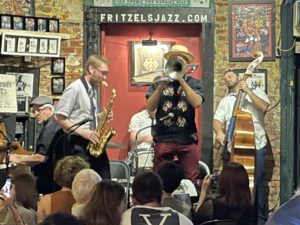 Friends of London City Singers might recognise Simon Arnott playing the sax. It’s a friendly place, with tasty beer and at this time of year has seats.
Friends of London City Singers might recognise Simon Arnott playing the sax. It’s a friendly place, with tasty beer and at this time of year has seats.
Next day is a significant birthday for Doris. That morning we look around the French Quarter.
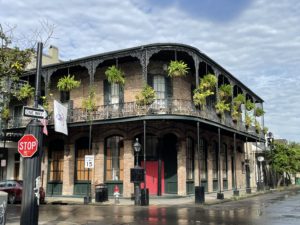 The wet street tells the story, this is hurricane season and we visit the Louisiana State museum describing Storm Katrina (2005).
The wet street tells the story, this is hurricane season and we visit the Louisiana State museum describing Storm Katrina (2005).
The exhibition starts by showing that experts predicted a big, but not wildly abnormal, hurricane would be deadly and economically catastrophic. Despite this, better engineering was delayed and contingency plans skimped. Though 80% of residents had evacuated by the time the storm hit 1,800 died. 80% of the city was flooded with $70bn of damage. News coverage of the water and winds makes you glad to have been elsewhere. Help was slow in coming to those stranded. It is reckoned the worst engineering disaster in US history. Maybe its just not a great place to have a large city?
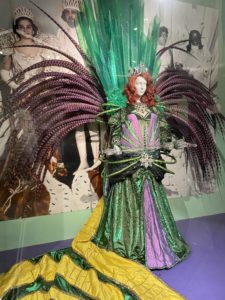 Much of the rest of the museum is given over to Mardi Gras, the Krewes and their costumes.
Much of the rest of the museum is given over to Mardi Gras, the Krewes and their costumes.
The French Quarter escaped the worst of Katrina and is also home to the Spanish Quarter. Founded by the French in 1718 NO was ceded to Spain in recompense for their having lost Florida to the British. (See 1782 Treaty of Fontainebleau for details.)
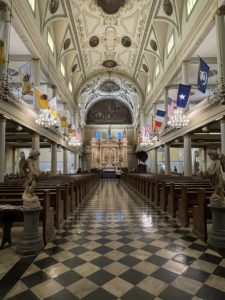 Right next door we visit St Louis Catholic Cathedral, the oldest in America.
Right next door we visit St Louis Catholic Cathedral, the oldest in America.
Doris is keen to see the old cemeteries where the water table requires all graves to be above ground to make a small City of the Dead.
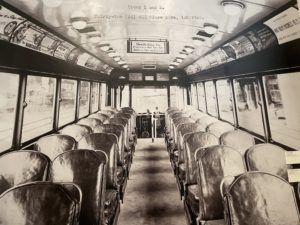 Doris is a genie of public transport and she whistles up a charming old tram which is just a normal part of the mass transit system.
Doris is a genie of public transport and she whistles up a charming old tram which is just a normal part of the mass transit system.
On the way Sid spots the ex-conveyance of the day.
Our route back to the hotel has to go by South Rampart Street because D has been at International Harmony Brigade singing S R Street Blues. See the sign through the rain? Don’t rain on her parade!
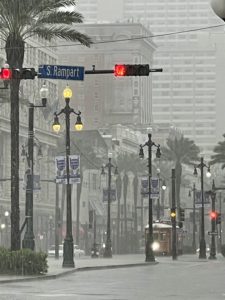 We get off the bus into a downpour. It is bucketing down but S and D are well covered with Goretex and umbrellas. A car ploughs through a small pond splashing Doris up to her chest and filling Sid’s shoes. Goretex can only do so much.
We get off the bus into a downpour. It is bucketing down but S and D are well covered with Goretex and umbrellas. A car ploughs through a small pond splashing Doris up to her chest and filling Sid’s shoes. Goretex can only do so much.
Doris takes a wander through the antique shops that were recommended by Dr Stancill in Laurel, There are very nice things made in the city in the 19th century though much of Keils’ jewellery stock comes from a London dealer.
Sid visits one of the plutocrats’ houses. There is always a panel to remind us that the wealth relied on slavery. Sid considers that maybe the UK has not quite caught up in thinking about life on 20th century tea and coffee plantations in India and East Africa.
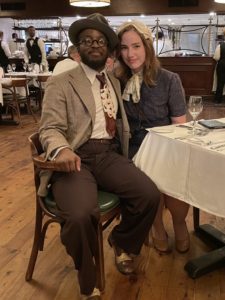 Dinner is at Mr B’s Bistro; excellent and made all the more fun by this couple in late 1920s costume. Think Damon Runyon’s Guys and Dolls.
Dinner is at Mr B’s Bistro; excellent and made all the more fun by this couple in late 1920s costume. Think Damon Runyon’s Guys and Dolls.
At Fritzel’s again we find a fabulous woman trumpeter leading a band with a load of energy. She and they are great and doing requests, so Doris asks for South Rampart Street Parade which is apparently much played at Mardi Gras. A good time is had by all, the tip bucket fills up and we stay up late (for us).
band with a load of energy. She and they are great and doing requests, so Doris asks for South Rampart Street Parade which is apparently much played at Mardi Gras. A good time is had by all, the tip bucket fills up and we stay up late (for us).
It is slightly poor form to publish someone else’s performance on YouTube, but this was a special song played just for Doris on a special day, so please enjoy it as a Happy Birthday celebration:
The last day in NOLA we visit the antique shops, walk out to Frenchman Street and go into the Cabildo. The state’s main administrative centre was built after the citywide fire of 1788, at the same time as the Presbytere and St Louis cathedral.
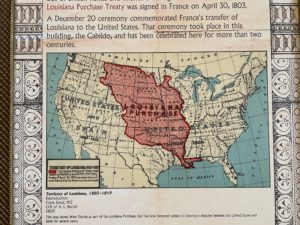
In 1803 Louisiana, not just the current Louisiana state but a territory that looks a lot like the whole Mississippi catchment area (see red area on map), was sold to the United States for $15m. Local curators are still trying to dispel the myth of the Purchase Treaty having been signed in the Cabildo rather than Paris, although Mr Google thinks he knows better.
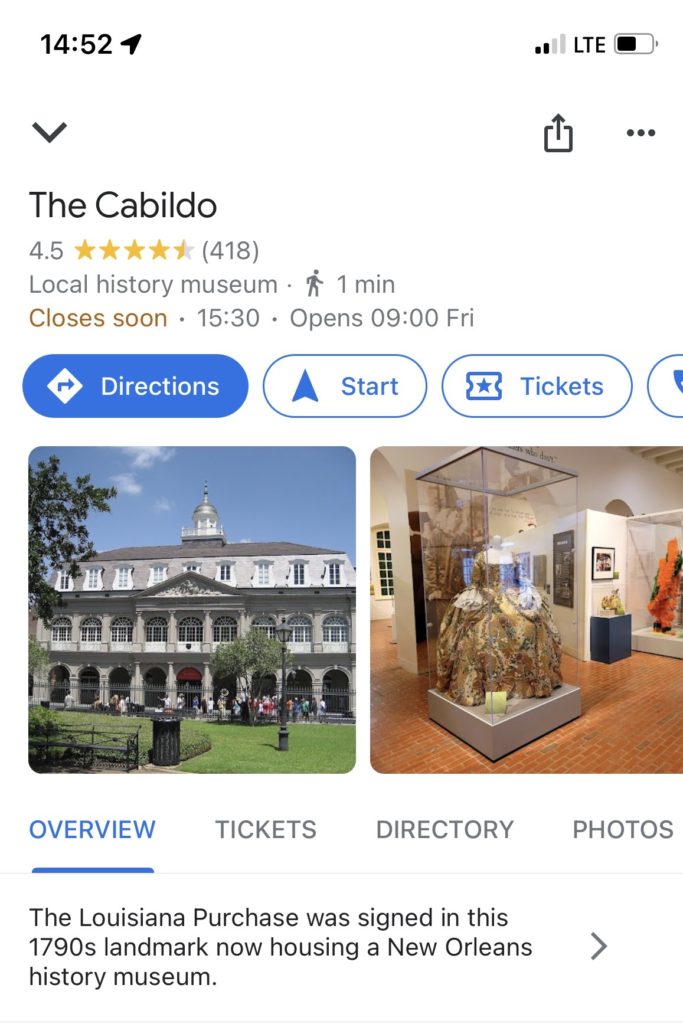
This is as far south as we are going. The next couple of days we will be heading east towards Jekyll Island, an exclusive resort for the grandest families of the gilded age. And now: Sid, Doris, S and Mr Jolly.